UCV Civil War Military Operations Marker #18: Charles Town 1863-1864
Introduction
Text-to-speech Audio
Images
Obelisk #18
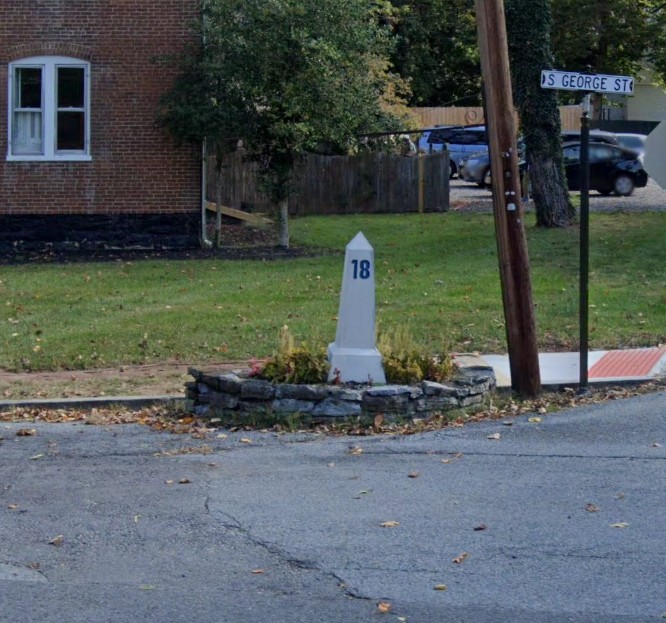
R. Preston Chew
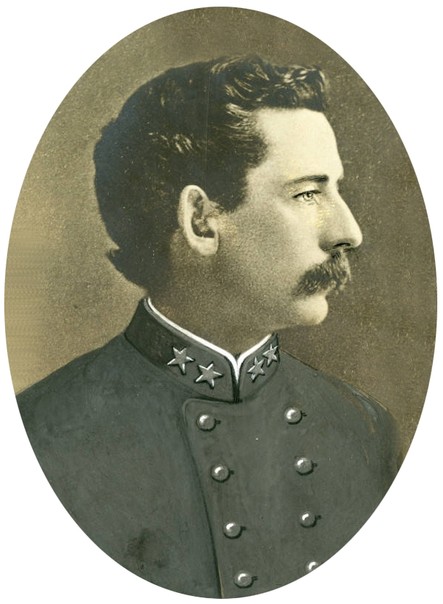
"The three story building with a "x" over it, in the right foreground of the image, quartered Union soldiers varies times during the Civil War including May 15, 1863 when an attack by a squad of Confederates, lead by Jefferson County's Captain R. Preston Chew, resulted in the capture of 60 Federals." (West Virginia & Regional History Center)
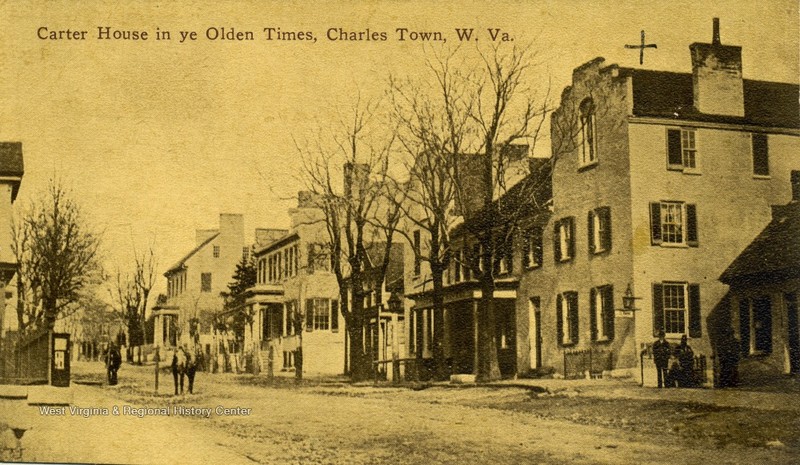
"Itinerary of the Second Division, Eighth Army Corps, April 4-May 28." Entry for May 15 (on p. 143) notes the rout of Confederates at Piedmont, VA and the recovery of the Charles Town raid prisoners.
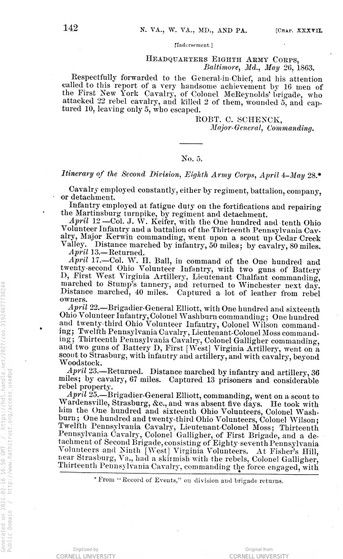
"Itinerary of the Second Division, Eighth Army Corps, April 4-May 28." Entry for May 15 notes the rout of Confederates at Piedmont, VA and the recovery of the Charles Town raid prisoners.
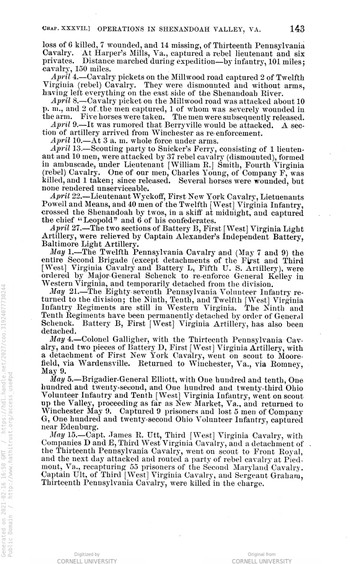
"Report of Lieut. Col. O. R. Funsten, Eleventh Virginia Cavalry." Second page of the report includes the raid by Chew on Charles Town in May 1863.
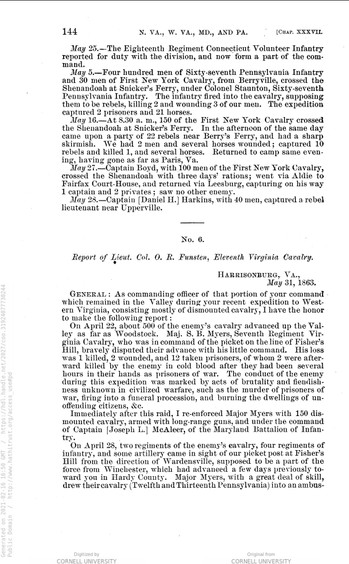
"Report of Lieut. Col. O. R. Funsten, Eleventh Virginia Cavalry." Second page of the report includes the raid by Chew on Charles Town in May 1863.
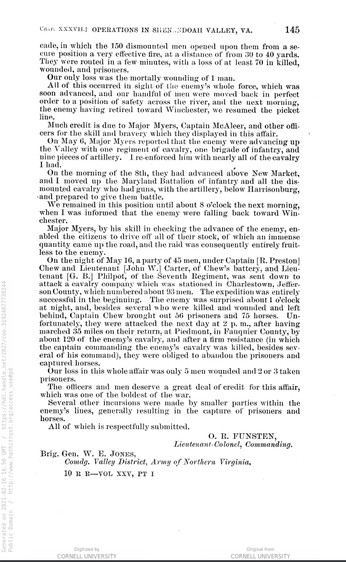
Report of Major General Robert H. Milroy regarding the recapture of Summers' men at Piedmont, VA
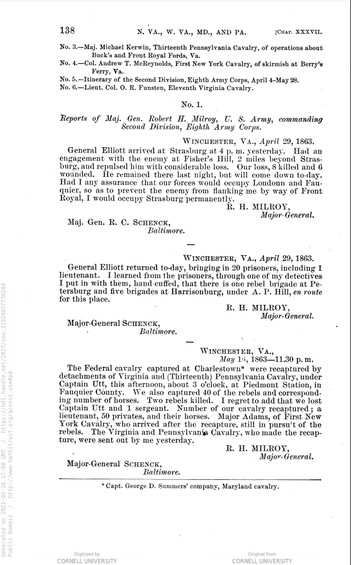
Confederate General John D. Imboden
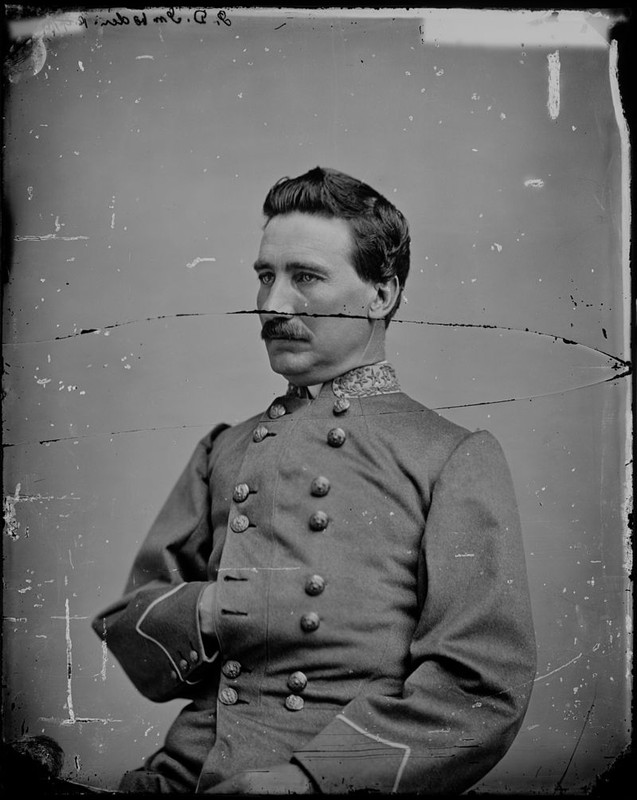
"Benjamin Louis Simpson (left) with an unidentified officer (Maryland Historical Society)
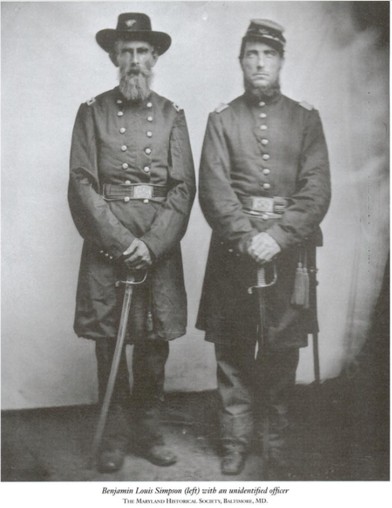
Official Reports for October 18, 1863 engagements, page 1
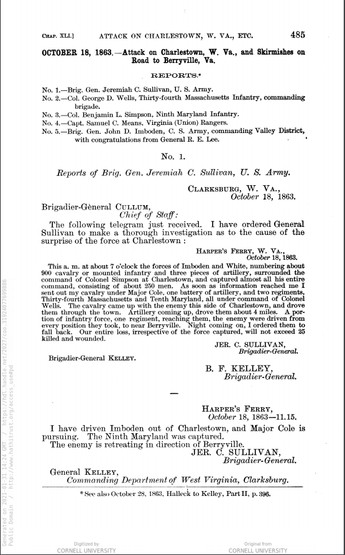
Official Reports for October 18, 1863 engagements, page 2
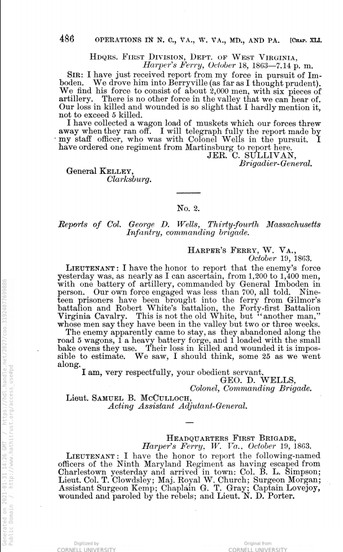
Official Reports for October 18, 1863 engagements, page 3
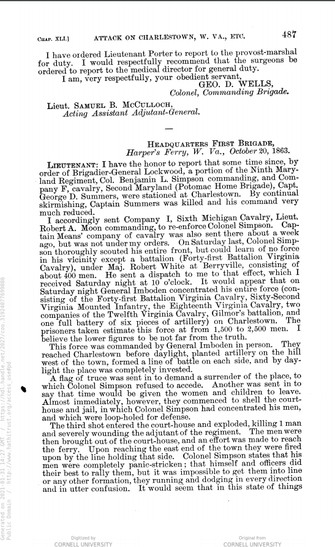
Official Reports for October 18, 1863 engagements, page 4
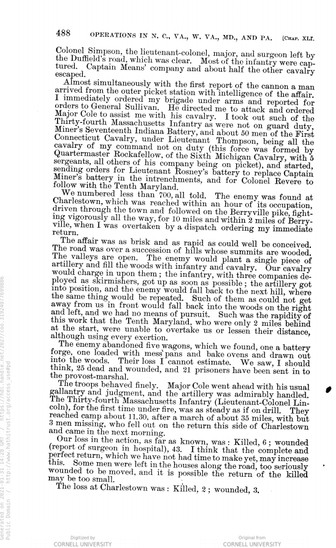
Official Reports for October 18, 1863 engagements, page 5
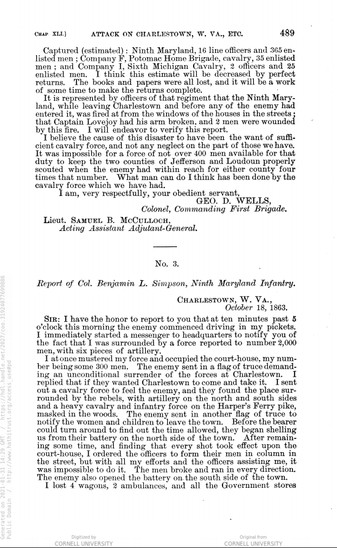
Official Reports for October 18, 1863 engagements, page 6
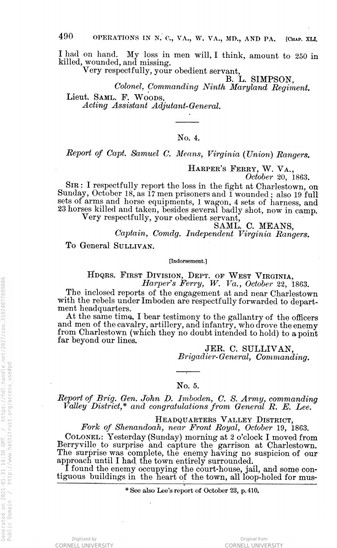
Official Reports for October 18, 1863 engagements, page 7
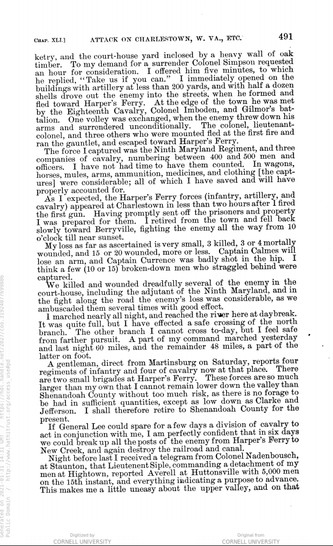
Official Reports for October 18, 1863 engagements, page 8
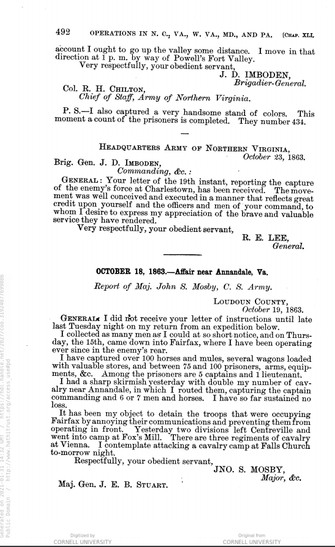
George Baylor
.jpg)
William Tibbett's report of December 1, 1864 mention's Baylor's raid
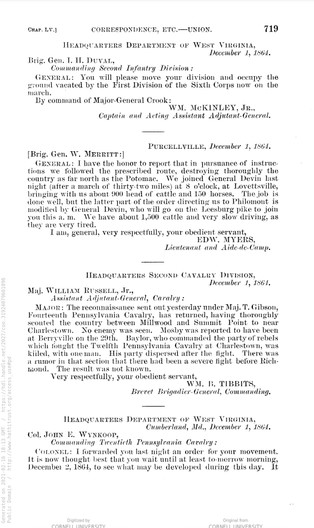
Report of Capt. Nathaniel Payne, Twelfth Pennsylvania Cavalry, November 30, 1864
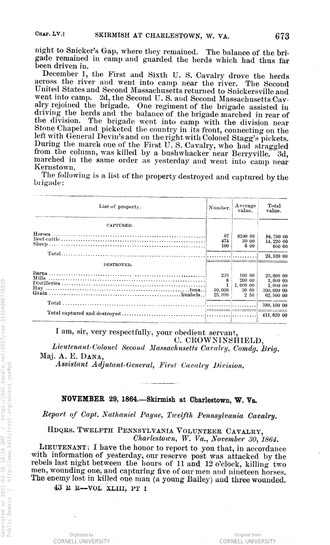
Report of Capt. Nathaniel Payne, Twelfth Pennsylvania Cavalry, November 30, 1864
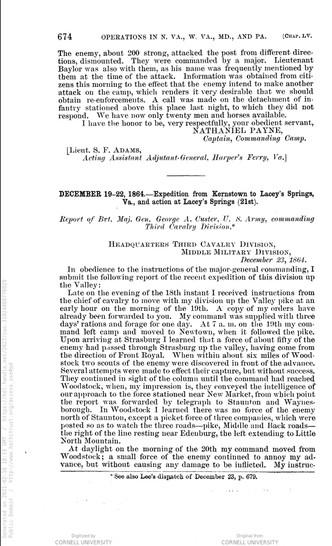
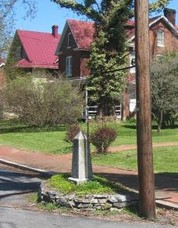
Backstory and Context
Text-to-speech Audio
Charles Town, WV saw constant activity during the Civil War and was the center of many engagements and actions. The men of the Jefferson County Camp, United Confederate Veterans likely highlighted these three events as important to the members of their organization, such as R. Preston Chew, who were directly connected to these raids and engagements.
May 16, 1863:
This was one of several raids and small engagements that occurred in Jefferson County during the spring of 1863. In mid-May Lieutenant George B. Philpott, Captain Preston Chew, and Lieutenant John W. Carter decided to raid Charles Town, WV. They gathered a party of 45 men and left their camp at Harrisonburg, VA on May 12th. The party crossed Myers Ford on the 16th and approached Charles Town. They dismounted at Tate’s Woods outside of town and entered the town on foot in the middle of the night. Stationed at Charles Town were 93 men under Captain George S. Summers with 75 horses. The Confederate raiders were able to completely surprise and surround Summers’ men who were largely quartered in the Court House and the Carter House (where the Bank of Charles Town now stands).
The Union troops in the Carter House saw the approaching raiders first and started firing their weapons, alerting the rest of the force in the Court House. It was too late however, and the Confederates secured the surrender of both parts of the Union force. Lieutenant Carter took care of the men in the Carter House while Captain Chew and Lieutenant Philpott handled the men in the Court House. Overall, the raiders captured 56 Union prisoners and 75 horses. Captain Summers was not in either building at the time of the attack and was able to escape being made a prisoner.
Once Chew, Carter, and Philpott had secured their prisoners and captured horses they quickly remounted and headed back up the Valley to avoid any pursuing Union force, recrossing Myers Ford around daylight. The raiders stopped to rest at Piedmont, VA and during their stop two of the raiders decided to visit friends since this was their hometown. While visiting these men met two other Confederates in town who seemed to know of the raid in Charles Town. Unfortunately for the raiders, these were two Federal soldiers in disguise. Quickly capturing the two raiders, the Union men gained information about the location of the main body of raiders and directed a force of about 120 Union cavalry to follow.
The force of Federal cavalry was able to overtake the raiders and after a short skirmish drove the Confederate raiders off. The Union was able to rescue all the Union prisoners as well as recover the stolen horses and supplies taken from Charles Town. They also took 3 Confederate prisoners.
October 18, 1863 (related to marker #14):
On October 18, 1863 General Lee organized an attack on Charles Town and Harpers Ferry to be conducted by Major Generals John D. Imboden and J. E. B. Stuart. The Confederate forces were to meet at Berryville, VA to coordinate their movements; however, Stuart was unable to cross the Shenandoah River due to high water and was unable to reach Imboden at Berryville. Imboden decided to modify the plan to attack only Charles Town. With his force of around 1,000 men he felt confident that they could counter the Union force stationed there. Imboden’s force left Berryville during the night/early morning of October 18th and was able to surround Charles Town before the Union troops were aware of their presence. He ordered the Confederates to surround the town and cut off all possible escape routes, then demanded surrender from Colonel Benjamin L. Simpson whose 9th Maryland Infantry was stationed in town. Simpson asked for an hour to consider the surrender; Imboden gave him five minutes and Simpson’s response was “Take us if you can.”
Imboden ordered his artillery to shell the courthouse and other buildings in town where the Union men were stationed, which forced the Union troops into the street. Simpson’s men attempted to retreat towards Harpers Ferry, but found the way blocked by Imboden, the 8th Cavalry, and Gilmor’s battalion. Colonel Simpson and a few other officers who were mounted were able to break through and escape, but the rest of the Union force was entirely captured by Imboden’s men. The force at Charles Town consisted of the 9th Maryland and three companies of cavalry (around 400-500 men) and when Imboden completed a count of the prisoners on October 19th he had taken 434 prisoners.
Union reinforcements from Harpers Ferry arrived about two hours after Imboden first fired on Charles Town. This force consisted of one battery of artillery, cavalry under Major Cole, and infantry from the 34th Massachusetts and 10th Maryland under Colonel George D. Wells. Imboden sent his prisoners towards Berryville and fought the pursuing Union force along the route for several hours. The Confederates held off the Union force, preventing them from rescuing the captured men, and Imboden was able to reach and cross the Shenandoah to Front Royal the next morning.
November 29, 1864
A number of raids and small engagements occurred in Jefferson County and the lower Shenandoah Valley during the fall, winter, and spring of 1864-1865 between Mosby’s Rangers and Union troops. One of these Confederate raider companies operating in the fall of 1864 was led by Lieutenant George Baylor, a local to Charles Town. He led a party of thirty men of Company B, Twelfth Virginia Cavalry in a raid on November 29, 1864 against a camp of men from the Twelfth Pennsylvania Cavalry. Baylor’s men were able to surprise the Union cavalrymen while they were sleeping, taking 27 prisoners and killing or wounding eleven.
About the Monuments:
This series of monuments and accompanying tour pamphlet were part of an initiative from the Jefferson County Camp, United Confederate Veterans to commemorate the 50th anniversary of the Civil War. In 1910 Col. R. Preston Chew and the Jefferson County UCV raised the funds to place 25 concrete obelisks in Jefferson County to mark locations of engagement or other significant events. The following year the Camp published a pamphlet to accompany the obelisks and give more information about each location. This was Military Operations in Jefferson County, Virginia (Now West Virginia), 1861-1865 published in 1911. The pamphlet has been reprinted several times by the Henry Kyd Douglas Camp, No. 199 of the Sons of Confederate Veterans. Because the monuments and accompanying pamphlet were done by Confederate veterans it is likely that the locations and descriptions are biased towards or favor the Confederate view and experience of the war.
Original Text from the 1911 Pamphlet:
"Marker Number Eighteen
Charles Town The Scene of Many Engagements
After Gen. William E. Jones had left New market on his West Virginia raid in May, 1863, Lieutenant G. B. Phillpott and Captain R. P. Chew gathered together about 45 men of Company “Q”, and crossing the mountain, went down the Luray Valley through Front Royal, crossing the Shenandoah river at Myers Ford about 11 o’clock at night May 15th.
They pursued their way to Tate’s woods, about three quarters of a mile from Charles Town. They dismounted here and tied their horses, and marched behind the house of Andrew Hunter, down the back street. Thence in front of Hawks’ Factory to George and turning moved in the direction of the Court House. Phillpott and Chew reached the old cattle scales where a sentinel challenged them and raised his gun. They both fired on him and he fled into the Court House yard and fell.
Summers’ Company was quartered in the Court House and the Carter House. They numbered about ninety men. A lieutenant and ten men stationed in the parlor of the Carter House opened fire upon us as soon as Phillpott and Chew fired upon the sentry. They kept up a constant fusillade.
It had been arranged that Lieutenant J. W. Carter of Chew’s Battery should attack and capture the soldiers in the Carter House. He was assigned six men for this purpose. When the Company reached the corner of the Court House yard, Carter with his men moved swiftly up the walk in front of the Court House, and crossing the street opposite the Carter house threw open the hall and entered the parlor.
Striking the lieutenant over the head with the butt of his pistol he demanded a surrender. The guard threw down their arms and were taken prisoners.
In the meantime Phillpott and Chew, with the remaining men, had entered the Court House and captured, without trouble, the balance of the company of Capt. Summers.
Summers, who happened to be out at the time of the attack, hid in the wood pile of Major Hawks, whose house was nearby.
The horses in the hotel stable were captured, and the men were mounted with the prisoners behind them.
Summers company numbered about ninety men, sixty of whom were captured with their arms, and about seventy five horses.
Returning through Tate’s woods the prisoners were mounted on the broken down horses, and at daylight the whole party recrossed the river at Myers’ Ford.
This capture was made without a single man being killed or wounded on either side. The Federals seemed dazed by the night attack and offered but feeble resistance.
On October 18, 1863, Gen. John D. Imboden marched to the vicinity of Charles Town for the purpose of capturing the enemy, who were posted there in large force. The 9th Maryland Regiment of Infantry and Capt, (sic) Summer’s Cavalry Company were quartered, the first in the Court House, and the latter in the Jail.
Imboden formed a line of battle on the Ranson farm west of the town, and extending his line to the east to the Kabletown road. He located a battery near the house of Robert Brown but found, after firing a few shots, he could not reach the Court House. He then extended his line across the Harpers Ferry road to the farm of James M. Ranson, and placing his gun on the hill north of town fired several shots through the Court House.
The enemy immediately evacuated the Court House and attempted a retreat towards Harpers Ferry but were intercepted by the Confederates and the entire command captured, excepting Summers’ company which effected its escape towards Leetown.
He then commenced to retreat by the pike to Berryville. He was pursued by a large force of the enemy and had a number of engagements between that point and Rippon. Here he formed in line to check the advance of the enemy and a serious engagement took place in which a number of men on both sides were killed and wounded.
An Account of the Fight of Baylor’s Company at Charles Town, November 29, 1864.
By Captain George Baylor
On the night of the 29th of November, 1864, with 30 men of Company B, we attacked the camp of the Twelfth Pennsylvania Cavalry at Charles Town. Passing through the enemy’s picket line, through a hollow just east of town, under cover of a fog such as usually hangs on autumn nights over the little valleys near the river and unobserved by the sentry on the adjacent hills, we reached in safety the north side of the town and the rear of the enemy’s camp, and road quietly to a point near the block house, about twenty yards from the camp. Here the men dismounted, leaving the horses in charge of the fourth man in each file of fours, and noiselessly gained the block house.
Stealthily moving on, the sleeping camp was entered, and the occupants awoke to find themselves prisoners. There was sudden confusion and scampering among the enemy. Some twenty of their number, lodged in a stone house nearby, opened fire on us. Recognizing the gravity of the situation, we rushed upon the house, and, seizing the doors and windows, poured several volleys into the building. Just as George Crayton, my brother Robert W. Baylor, Jr. (a boy of seventeen) and myself entered the door, several shots were fired by the inmates, one mortally injuring my brother and another severely injuring Crayton. After a few minutes the cry of surrender came from the group huddled together in the building, and the firing ceased. My brother and Crayton were removed to the house of Dr. Mason, who had been for years our family physician, and where I knew they would be well cared for. My brother died in a few hours, but Crayton rallied for a while and died soon after the close of the war. The loss of these two gallant soldiers was deeply deplored by their comrades, and especially by myself. In this engagement we killed and wounded 11 of the enemy, captured 27 prisoners and 37 horses and equipments.
It seems a little strange in the light of recent publications of the War Records that success attended us in this attack, for we find that as early as November 23d, the day after the attack at Keyes’ Ford, General Sheridan dispatched General Stevenson at Harpers Ferry as follows:
‘Kernstown, Va., November 23, 1864
General: It is reported that Major Congdon, of the Twelfth Pennsylvania Cavalry, reports the enemy in force at or near Charles Town. Find out if he has made this untruthful report. If the Twelfth Pennsylvania Cavalry cannot keep that country clear of guerillas, I will take the shoulder straps off every officer belonging to the regiment and dismount the regiment in disgrace.
P. H. Sheridan, Major-General’
And on the 28th of the same month he wires the commanding officer at Charles Town:
‘Kernstown, Va., November 28, 1864
Commanding Officer, Charlestown, Va.
Lookout for Mosby tonight.
P.H. Sheridan, Major-General’
And Captain Paine, Commanding the Twelfth Pennsylvania on the night of the attack in his report, says:
‘I have the honor to report that in accordance with information of yesterday, our reserve post was attacked by the rebels last night between the hours of 11 and 12 o’clock, killing two men, wounding one, and capturing five of our men and 19 horses. The enemy lost in killed, one man (a young Baylor) and three wounded. They were about 200 strong, and attacked the post from different directions, dismounted. They were commanded by a Major. Lieutenant Baylor was also with them, as his name was frequently mentioned by them at the time of the attack.
Nathaniel Payne, Captain Commanding
Lieutenant S. F. Adams,
Acting Assistant Adjutant-General
Harpers Ferry, W. Va.’
The eyes of the Captain on that night evidently had large magnifying powers when viewing our little band of 30 men, and corresponding minimizing powers when recounting his loss on that occasion. He was afraid of General Sheridan’s threat.
After the fight at Charles Town, we retired to the neighborhood of Milldale, and got rid of our prisoners and booty. The enemy, it seems, took a scout around, as usual after a fight, and reported as follows:
‘Headquarters Second Cavalry Division
December 1, 1864
Major William Russell, Jr.,
Assistant Adjutant General Cavalry:
Major: The reconnaissance sent out yesterday under Major T. Gibson, Fourteenth Pennsylvania Cavalry, has returned, having thoroughly scouted the country between Milldale and Summit Point to near Charles Town. No enemy was seen. Mosby was reported to have been in Berryville on the 29th. Baylor, who commanded the party of rebels which fought the Twelfth Pennsylvania Cavalry at Charles Town, was killed, with one man. The party dispersed after the fight.
Very respectfully, your obedient servant,
Wm. B. Tibbitts,
Brevet Brigadier General Commanding’"
Cite This Entry
MacKay, Iain, Jefferson County Historic Landmarks Commission, and Kathleen Thompson. "UCV Civil War Military Operations Marker #18: Charles Town 1863-1864." Clio: Your Guide to History. February 16, 2021. Accessed March 24, 2025. https://theclio.com/tour/1805/18/reverse
Sources
Bushong, Millard Kessler. A History of Jefferson County, West Virginia. Charles Town, WV: Jefferson Publishing Company, 1941.
Engle, Stephen Douglas. Thunder in the Hills: Military Operations in Jefferson County, West Virginia, During the American Civil War. Charleston, WV: Mountain State Press, 1989.
Military Operations in Jefferson County Virginia (and West Va.) 1861-1865. Published by Authority of Jefferson County Camp U.C.V. Farmers Advocate Print, 1911. Accessed January 20, 2021. https://babel.hathitrust.org/cgi/pt?id=uc2.ark:/13960/t4vh5gp6c&view=1up&seq=5.
Official Records, Series 1, Volume 29, Part 1, p. 485-92. Timeline of West Virginia: Civil War and Statehood October 22, 1863. Child of the Rebellion: An Archives and History Sesquicentennial Project. West Virginia Department of Arts, Culture and History. Accessed January 31, 2021. http://www.wvculture.org/history/sesquicentennial/18631018.html.
Google Maps. Accessed February 16, 2021.
"R. Preston Chew." Wikipedia. Accessed February 16, 2021. https://en.wikipedia.org/wiki/R._Preston_Chew.
"Carter House in Charles Town, W. Va." West Virginia History OnView. West Virginia & Regional History Center. Accessed February 16, 2021. https://wvhistoryonview.org/catalog/037965.
The War of the Rebellion: a Compilation of the Official Records of the Union and Confederate Armies. Series.1:vol.25:pt.1:Reports. p. 142. Accessed February 16, 2021. https://babel.hathitrust.org/cgi/pt?id=coo.31924077730244&view=1up&seq=3
The War of the Rebellion: a Compilation of the Official Records of the Union and Confederate Armies. Series.1:vol.25:pt.1:Reports. p. 143. Accessed February 16, 2021. https://babel.hathitrust.org/cgi/pt?id=coo.31924077730244&view=1up&seq=3
The War of the Rebellion: a Compilation of the Official Records of the Union and Confederate Armies. Series.1:vol.25:pt.1:Reports. p. 144. Accessed February 16, 2021. https://babel.hathitrust.org/cgi/pt?id=coo.31924077730244&view=1up&seq=3
The War of the Rebellion: a Compilation of the Official Records of the Union and Confederate Armies. Series.1:vol.25:pt.1:Reports. p. 145. Accessed February 16, 2021. https://babel.hathitrust.org/cgi/pt?id=coo.31924077730244&view=1up&seq=3
The War of the Rebellion: a Compilation of the Official Records of the Union and Confederate Armies. Series.1:vol.25:pt.1:Reports. p. 138. Accessed February 16, 2021. https://babel.hathitrust.org/cgi/pt?id=coo.31924077730244&view=1up&seq=3
"John D. Imboden." Wikipedia. Accessed January 31, 2021. https://en.wikipedia.org/wiki/John_D._Imboden.
Hunt, Roger D. Colonels in Blue: Union Army Colonels of the Civil War, The Mid-Atlantic States, Pennsylvania, New Jersey, Maryland, Delaware, and the District of Columbia. Mechanicsburg, PA: Stackpole Books, 2007. Image on page 230. Accessed January 31, 2021. https://books.google.com/books?id=7X97CKjWKLcC&printsec=frontcover#v=onepage&q&f=false.
The War of the Rebellion: a Compilation of the Official Records of the Union and Confederate Armies. Series.1:vol.29:pt.1:Reports. p. 485. Accessed January 31, 2021. https://babel.hathitrust.org/cgi/pt?id=coo.31924077699886&view=1up&seq=3.
The War of the Rebellion: a Compilation of the Official Records of the Union and Confederate Armies. Series.1:vol.29:pt.1:Reports. p. 486. Accessed January 31, 2021. https://babel.hathitrust.org/cgi/pt?id=coo.31924077699886&view=1up&seq=3.
The War of the Rebellion: a Compilation of the Official Records of the Union and Confederate Armies. Series.1:vol.29:pt.1:Reports. p. 487. Accessed January 31, 2021. https://babel.hathitrust.org/cgi/pt?id=coo.31924077699886&view=1up&seq=3.
The War of the Rebellion: a Compilation of the Official Records of the Union and Confederate Armies. Series.1:vol.29:pt.1:Reports. p. 488. Accessed January 31, 2021. https://babel.hathitrust.org/cgi/pt?id=coo.31924077699886&view=1up&seq=3.
The War of the Rebellion: a Compilation of the Official Records of the Union and Confederate Armies. Series.1:vol.29:pt.1:Reports. p. 489. Accessed January 31, 2021. https://babel.hathitrust.org/cgi/pt?id=coo.31924077699886&view=1up&seq=3.
The War of the Rebellion: a Compilation of the Official Records of the Union and Confederate Armies. Series.1:vol.29:pt.1:Reports. p. 490. Accessed January 31, 2021. https://babel.hathitrust.org/cgi/pt?id=coo.31924077699886&view=1up&seq=3.
The War of the Rebellion: a Compilation of the Official Records of the Union and Confederate Armies. Series.1:vol.29:pt.1:Reports. p. 491. Accessed January 31, 2021. https://babel.hathitrust.org/cgi/pt?id=coo.31924077699886&view=1up&seq=3.
The War of the Rebellion: a Compilation of the Official Records of the Union and Confederate Armies. Series.1:vol.29:pt.1:Reports. p. 492. Accessed January 31, 2021. https://babel.hathitrust.org/cgi/pt?id=coo.31924077699886&view=1up&seq=3.
Robertson, James Jr. "George Baylor." Radio IQ wvtf (Virginia's Public Radio). September 16, 2019. Accessed February 14, 2021. https://www.wvtf.org/post/george-baylor#stream/0.
The War of the Rebellion: a Compilation of the Official Records of the Union and Confederate Armies. Series.1:vol.43:pt.2:Correspondence. p. 719. Accessed February 16, 2021. https://babel.hathitrust.org/cgi/pt?id=coo.31924077699886&view=1up&seq=3.
The War of the Rebellion: a Compilation of the Official Records of the Union and Confederate Armies. Series.1:vol.43:pt.1:Reports. p. 673. Accessed February 16, 2021. https://babel.hathitrust.org/cgi/pt?id=coo.31924077699886&view=1up&seq=3.
The War of the Rebellion: a Compilation of the Official Records of the Union and Confederate Armies. Series.1:vol.43:pt.1:Reports. p. 6743. Accessed February 16, 2021. https://babel.hathitrust.org/cgi/pt?id=coo.31924077699886&view=1up&seq=3.

